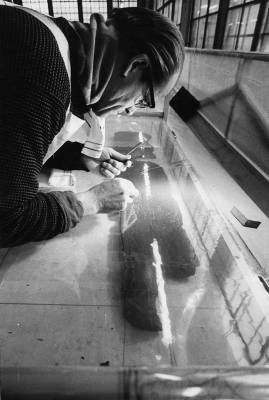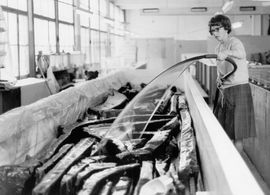Drawing on drafting foil
Before conservation, all the ship parts have to be measured and drawn. The illustrators places each ship part under a glass plate with transparent drafting foil in top. All lines and details are drawn in full scale.
The foil drawings are used to show the shape and size of the ship parts, and can be assembled to give the first impression of a ship's design.
By 1967, all the ship parts are recorded on long drafting foil sheets, measuring two kilomtres in total.
In 2000, drawing on foil is replaced by 3D measurement. An electronic pen is moved across the forms and edges of the ship parts and the 3D measurements are inputted derectly into a computer.
Conservation
After 1,000 years under water, the wood of the ships is fragile and broken down by bacteria and fungi. The wood cells are full of water, and if the wood is allowed to dry, it will shrink and crumble. The ships must be conserved to preserve for posterity.
In 1962, new research shows that polyethylene glycol (PEG), a waxy material, can fill in the wood cells and ensure that the ship parts retain their shape, size and surface texture.
The conservation process takes place in large tanks filled with PEG dissolved in distilled water. The aim is to allow the glycol mixture to replace the water in the wood, which is then stabilised. The process takes from six month to two years for each ship part.
The conservation could be completed in 1975. Not all ship parts had survived the process when the tanks were emptied. Some parts had shrunk and had to be re-conserved.

